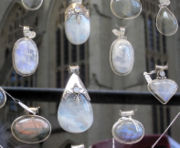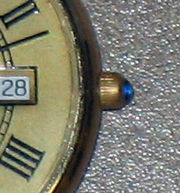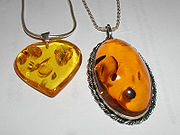
Cabochon
Encyclopedia



Gemstone
A gemstone or gem is a piece of mineral, which, in cut and polished form, is used to make jewelry or other adornments...
which has been shaped and polished as opposed to facet
Facet
Facets are flat faces on geometric shapes. The organization of naturally occurring facets was key to early developments in crystallography, since they reflect the underlying symmetry of the crystal structure...
ed. The resulting form is usually a convex top with a flat bottom. Cutting en cabochon is usually applied to opaque gems, while faceting is usually applied to transparent stones. Hardness is also taken into account as softer gemstones with a hardness lower than 7 on the Mohs hardness scale
Mohs scale of mineral hardness
The Mohs scale of mineral hardness characterizes the scratch resistance of various minerals through the ability of a harder material to scratch a softer material. It was created in 1812 by the German geologist and mineralogist Friedrich Mohs and is one of several definitions of hardness in...
are easily scratched, mainly by silicon dioxide
Silicon dioxide
The chemical compound silicon dioxide, also known as silica , is an oxide of silicon with the chemical formula '. It has been known for its hardness since antiquity...
in dust and grit. This would quickly make translucent gems unattractive—instead they are polished as cabochons, making the scratches less evident.
In the case of asteriated
Asterism (gemmology)
Asteria, or star stone is a name applied to ornamental stones that exhibit a luminous star when cut en cabochon. The typical asteria is the star-sapphire, generally a bluish-grey corundum, milky or opalescent, with a star of six rays...
stones such as star sapphire
Sapphire
Sapphire is a gemstone variety of the mineral corundum, an aluminium oxide , when it is a color other than red or dark pink; in which case the gem would instead be called a ruby, considered to be a different gemstone. Trace amounts of other elements such as iron, titanium, or chromium can give...
s and chatoyant
Chatoyancy
In gemology, chatoyancy , or chatoyance, is an optical reflectance effect seen in certain gemstones. Coined from the French "œil de chat," meaning "cat's eye," chatoyancy arises either from the fibrous structure of a material, as in tiger eye quartz, or from fibrous inclusions or cavities within...
stones such as cat's eye chrysoberyl
Chrysoberyl
The mineral or gemstone chrysoberyl is an aluminate of beryllium with the formula BeAl2O4. The name chrysoberyl is derived from the Greek words χρυσός chrysos and βήρυλλος beryllos, meaning "a gold-white spar". Despite the similarity of their names, chrysoberyl and beryl are two completely...
, a domed cabochon cut is used to show the star or eye, which would not be visible in a faceted cut.
The usual shape for cutting cabochons is an ellipse. This is because the eye is less sensitive to small asymmetries in an ellipse, as opposed to a uniformly round shape, such as a circle, and because the elliptical shape, combined with the dome, is attractive. An exception is cabochons on some watches' crowns, which are round.
The procedure is to cut a slab of the rough rock with a slab saw. Next stencil a shape from a template. The slab is then trimmed to near the marked line using a diamond blade saw—called a trim saw. Diamond impregnated wheels or silicon carbide wheels can be used to grind the rough rock down. Most lapidary workshops and production facilities have moved away from silicon carbide to diamond grinding wheels or flat lap disks.
Once the piece is trimmed it can be "dopped" or completed by hand. "Dopping" is normally done by adhering the stone with hard wax onto a length of wooden dowel called a "drop stick". The piece is then ground to the template line, the back edges may be bevelled, and finally the top is sanded and polished to a uniform dome.

